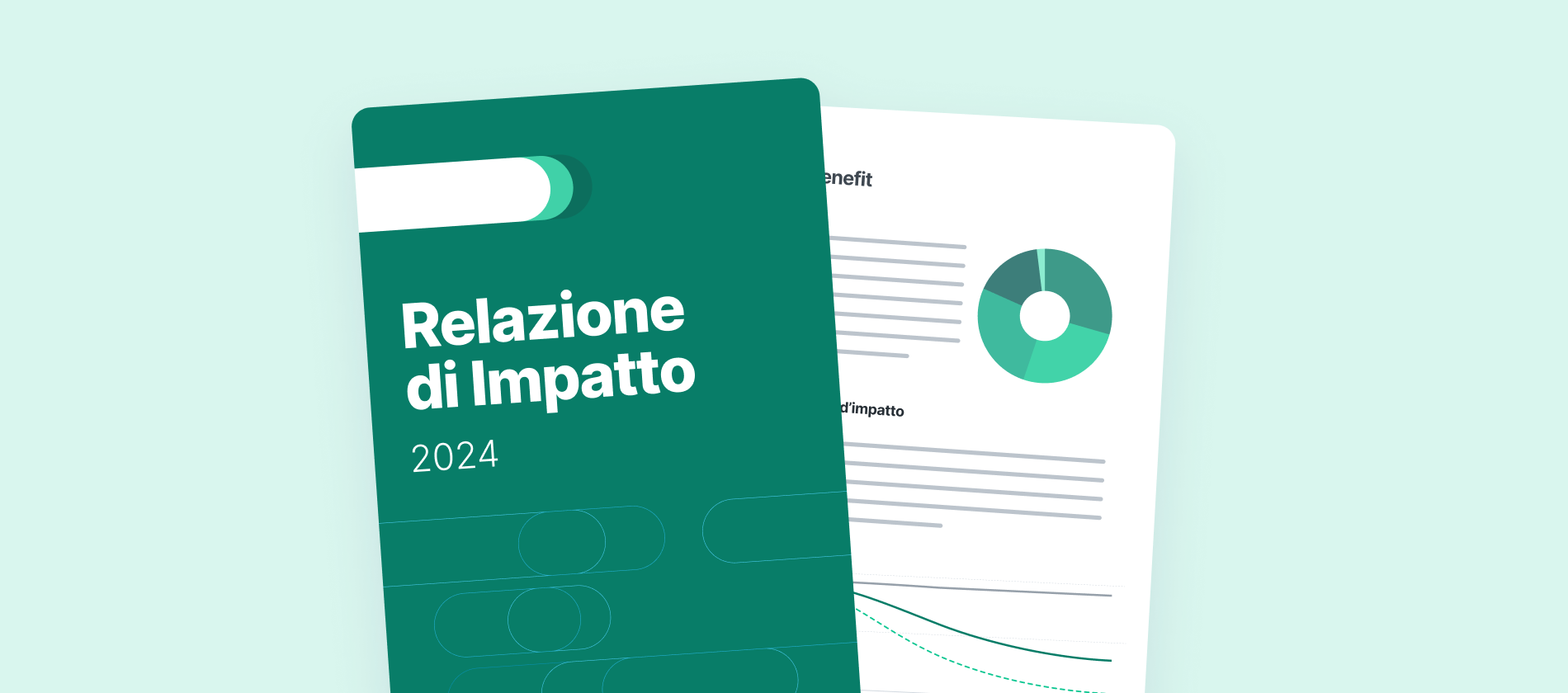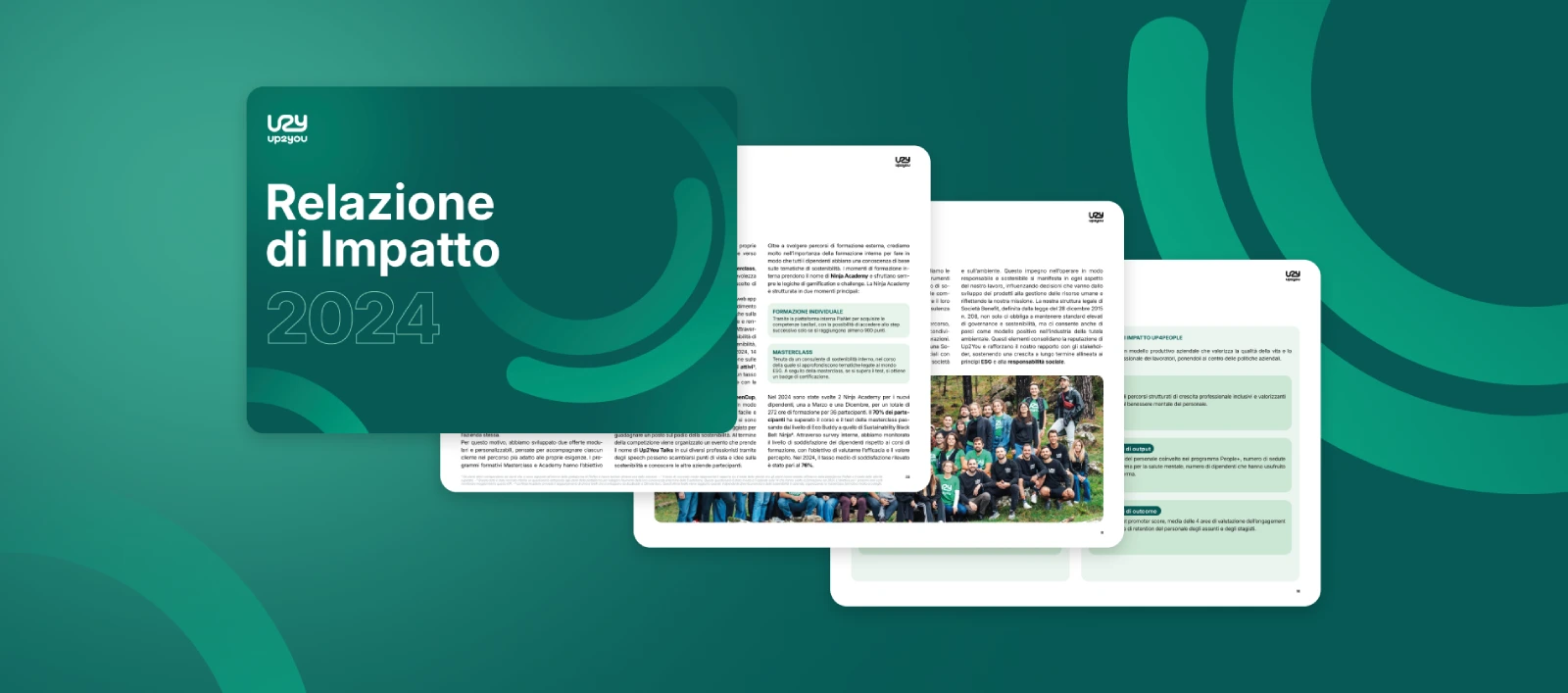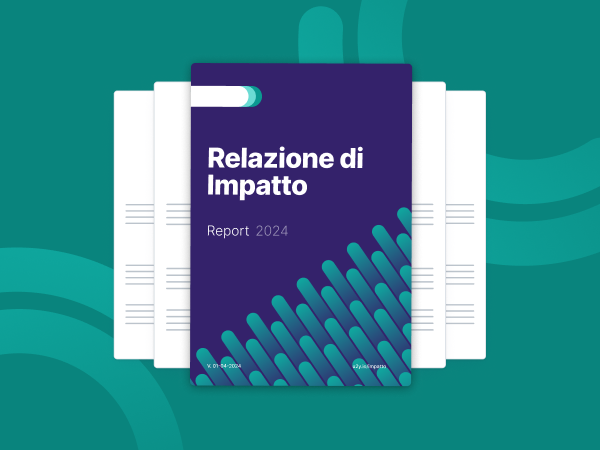{summary#bullet-1}
What is the impact report
The impact report is an official document that by law every Benefit Company is required to draft and publish annually, attached to financial statements. It is a tool of transparency and reporting which describes in a clear and verifiable way the actions taken to pursue the purposes of common benefit, as defined in the corporate by-laws.
The concept of Benefit Corporation was born in United States: the first state to introduce this legal form was the Maryland in 2010, followed in the following years by many other American states. Italy has officially recognized the form of Benefit Company in January 2016 with Law 208/2015, becoming the second country in the world to adopt this legal innovation.
Unlike traditional companies, which are mainly oriented to profit maximization for shareholders, Benefit Companies are distinguished by their formal integration into their corporate purpose of environmental and social objectives. This is also reflected in reporting practices, which cannot be limited to only economic results, but they must include the impact generated on social and environmental plan.
The impact report complies with what was established by Article 5 of the law on benefit corporations, which defines their mandatory minimum contents:
- the description of the common benefit objectives, of the methods adopted and of the concrete actions implemented to pursue them;
- the assessment of the impact generated, carried out through the use of an external, credible and transparent measurement standard (such as the Benefit Impact Assessment);
- The objectives for the following year, with an indication of the areas for improvement and the planned strategies;
- the publication of the report on the company website, if any, to make it accessible to all stakeholders.
However, the impact report is not only a regulatory compliance: represents a crucial moment of strategic reflection. It is a tool that allows the company to verify the consistency between missions, actions and results, strengthening its identity and the alignment between operational activities and the impacts generated.
{summary#bullet-2}
What does an impact report contain
La impact report It is a document that photographs in a transparent and structured way the identity of a Benefit Corporation, recounting its concrete commitment to Generate value for society and for the environment.
To draft it, it is necessary to do a job of deep analysis, what a start come on founding values of the company to get to real actions completed during the year.
The relationship opens with the description of the purposes of common benefit, that is, what the company intends to pursue in addition to profit. It is important to explain what it means, in the specific business context, to contribute to the common good, clearly defining the social and environmental objectives included in the statute.
Follow the reporting of the activities carried out: the document must account for concrete actions implemented to achieve these objectives, including any hardships meet along the way. It is therefore a question of quantify the efforts made, giving an exhaustive account of the initiatives related to the core business, policies towards employees, projects in favor of the environment or the community.
For example, if the goal is the Decarbonization, actions such as the reduction of waste, the promotion of sustainable mobility or participation in reforestation programs may be highlighted.
The central element of the relationship is the assessment of the impact generated. This must be carried out through an external, objective and recognized measurement standard, which analyzes the company performance in at least 4 fundamental areas.
- Governance: degree of transparency and responsibility in business management, attention to the social mission, involvement of stakeholders, clarity of the policies adopted.
- Workers: quality of internal relationships, salaries, benefits, opportunities for growth, organizational well-being, flexibility and security.
- External Stakeholders: relationships with suppliers, local communities and territory, volunteer initiatives, donations and cultural activities.
- Environment: environmental impacts along the life cycle of products or services, from the use of resources and energy to logistics, consumption and end of life.
Finally, the report is completed with the definition of future objectives, that is, the goals that the company intends to pursue innext year. This part not only has informational value, but it becomes the basis on which to build long-term commitment and activate paths of continuous improvement.
In addition to these mandatory elements, the relationship may also include a series of virtuous practices that reflect the identity of the company and its positive impact on the community. These include, for example: corporate code of ethics, volunteer activities, training courses, team building initiatives, smart working regulations, events open to the public and sustainable incentive plans.

{summary#bullet-3}
5 steps to draft an impact report
1. Definition of methodology and impact objectives
The drafting of the impact report begins with the identification of the areas in which the company generates value, precisely defining the common benefit objectives and their alignment with the business strategy.
At this stage it is important to distinguish between direct beneficiaries, who receive an immediate impact from the activities, and indirect beneficiaries, who will benefit in the long run.
For effective prioritization, it is useful to combine an approach Top-down, inspired by global frameworks such as the UN SDGs, with an approach Bottom-up, which involves active listening to stakeholders and the enhancement of internal resources.
2. Impact Value Chain analysis and impact mapping
Once the objectives have been defined, we move on to impact mapping through the Impact Value Chain. This model makes it possible to identify and relate 4 key elements:
- Inputs: the resources invested (time, human capital, materials, skills)
- Activity: the actions taken to generate impact
- Output: the immediate and tangible results of the activities
- Outcome: the changes generated at the social and environmental level
For each impact area, it is necessary to identify a set of KPI quantitative and qualitative capable of accurately measuring outputs and outcomes, making the results readable and comparable.
3. Data collection and monitoring
Once the mapping phase is over, the company must proceed with the collection and the data monitoring, involving internal and external stakeholders.
This phase aims to build a solid information base, useful both for reporting and for evaluating results.
The use of digital tools and data collection platforms allows a more efficient and continuous monitoring, improving the accuracy of the measurements and facilitating the analysis of the impacts generated.
4. Structuring the impact report
At this point, we proceed with the drafting real relationship. The document must be clearly structured, accessible and compliant with regulatory guidelines, in particular Annex 4 of Art. 1, paragraph 378 of the Law on Benefit Companies.
The report should contain:
- KPIs related to outputs and outcomes, represented by tables, graphs or visual dashboards;
- the description of the methods used for measuring and evaluating impact;
- a section dedicated to critical analysis the results achieved and any difficulties encountered;
- the summary of the impacts generated and the identification of areas for improvement;
- if available, theInsertion of the BIA assessment (Benefit Impact Assessment) as an additional tool for transparency and credibility.
5. Continuous improvement and impact review
The last step consists of an in-depth reflection on the results obtained, aimed atoptimization of future strategies.
The impact report should not be seen only as a reporting exercise, but as a cyclical learning process, useful for strengthening the alignment between vision, operation and impact.
Analyzing critical issues, dealing with feedback from stakeholders and updating objectives allows you to transform the relationship into a dynamic tool for growth and innovation. Only in this way can it represent a concrete lever for sustainable change.
Find out in detail what are the 5 steps to draw up an impact report in these Up2You guides
{summary#bullet-4}
The 7 advantages of becoming a benefit corporation
Adopt the legal status of Benefit Company means embarking on an ambitious path of transformation of corporate identity, capable of combining economic profitability and positive impact on society and the environment.
But beyond the value commitment, becoming a Benefit Company also involves concrete advantages that affect every level of the organization: from management to shareholders, from employees to investors, to customers.
Let's see what they are.
1. Improving reputation and value leadership
Being recognized as a Benefit Corporation reinforces the company's reputation, communicating an authentic commitment to corporate sustainability and the common good. In a market that is increasingly sensitive to environmental, social and ethical issues, this choice positions the company among the leaders of a new responsible economy.
2. Attracting and retaining talent
The new generations of workers, in particular Millennials and Gen Z, are increasingly motivated by goals that go beyond profit. Becoming a Benefit Company allows the company to demonstrate a legal and concrete commitment to generating a positive impact, making it more attractive to motivated talents and reducing turnover.
3. Easy access to capital and impact investments
Benefit Companies offer investors greater guarantees with respect to the consistency and continuity of the corporate mission. This is especially true for impact investors, who are looking for opportunities aligned with their values, but also for venture capital funds and responsible investment platforms.
4. Redefinition of management responsibilities
The legal form of Benefit Companies allows directors to legitimately balance economic objectives with impact objectives, protecting them even in complex situations such as a sale or a stock exchange listing. This is a guarantee that protects the mission in the long term and allows for more sustainable decisions, without the fear of being tied exclusively to maximizing profit for shareholders.
5. Protecting the company mission over time
Benefit Companies introduce a legal constraint to their social and environmental purpose, protecting it even in moments of transition or change. This feature is particularly relevant for listed companies or companies about to attract retail capital, offering a form of protection against the short-term pressure that often characterizes financial markets.
6. Stimulating innovation and sustainable growth
Integrating positive impact into business strategy stimulates the search for new solutions, business models and products. Benefit Companies, by their nature, must constantly question themselves about the consequences of their activities and this leads, in many cases, to a competitive advantage in terms of creativity, adaptability and long-term vision.
7. Potential tax and regulatory benefits
In some legislative contexts, Benefit Companies can access public incentives, dedicated calls or tax breaks, which reward companies oriented to sustainability and shared value. Although the regulatory framework in Italy is evolving, this trend is growing and represents an additional incentive to adopt this legal form.

{summary#bullet-5}
A concrete example: Up2You's impact report
how Benefit Corporation and B Corp certified, Up2You strives every day to generate a measurable and lasting positive impact. Our impact report is the tool with which we account for this commitment, so transparent and structured, with respect to all our stakeholders.
The method we have adopted to evaluate our impact is based on Theory of Change And onactive listening to stakeholders key: top management, employees and customers.
Starting from these elements, we have built our Impact Value Chain, clearly identifying the connections between the activities we carry out and the changes we intend to generate, both at an environmental and social level. For each objective, we have defined indicators qualitative and quantitative, also making use of the international standard B Impact Assessment, and developed ad hoc survey tools to monitor their evolution over time.
For us, evaluating impact means not only demonstrating the results achieved, but above all activate a continuous improvement process, to make our value proposition more solid and meaningful every day.
Do you want to find out how an impact report is structured?
Download the Up2You impact report





























